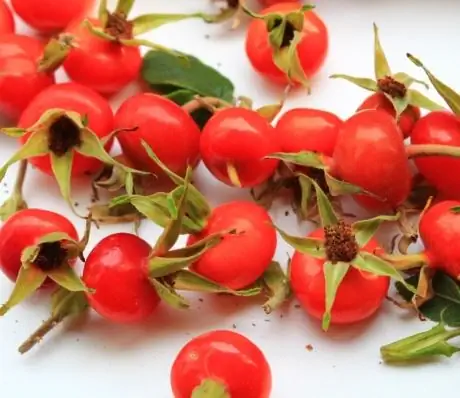- Author Rachel Wainwright [email protected].
- Public 2023-12-15 07:39.
- Last modified 2025-11-02 20:14.
Pollock
Pollock is a marine fish from the cod family. She lives in the cold waters of the marginal seas of the Pacific Ocean - Okhotsk, Bering and Japanese. The Atlantic pollock subspecies is found in the Barents Sea. Pollock is one of the longest-livers among fish and lives up to 20 years. Adults reach a mass of up to 5 kg and a meter in length. But the main part of the catch is fish weighing up to 1.5 kg and no more than 50 cm long.
The ratio of BJU in the product

Source: depositphotos.com How to burn 111 kcal?
| Walking | 28 minutes |
| Jogging | 12 minutes |
| Swimming | 9 minutes |
| A bike | 16 minutes |
| Aerobics | 22 minutes |
| Household chores | 37 minutes |
Pollock is a marine fish from the cod family. She lives in the cold waters of the marginal seas of the Pacific Ocean - Okhotsk, Bering and Japanese. The Atlantic pollock subspecies is found in the Barents Sea. Pollock is one of the longest-livers among fish and lives up to 20 years. Adults reach a mass of up to 5 kg and a meter in length. But the main part of the catch is fish weighing up to 1.5 kg and no more than 50 cm long.
Pollock goes on sale in dried, dried and frozen form, as well as in the form of canned food. Pollock roe is also very tasty, which in terms of nutritional properties is equated to salmon and sturgeon caviar. Pollock liver in its qualities is equated to cod liver. Pollock meat is used to make surimi, which is the main ingredient in crab sticks.
Fresh pollock practically does not go on sale, so it is better to buy fillets of this fish, covered with ice glaze, which protects the meat from drying out. A good fillet should be white with no yellow or pink tint. Defrost it either in a cup of cold water or on the bottom shelf of the refrigerator. Pollock cannot be re-frozen.
The composition and calorie content of pollock
100.0 g of pollock fillet contains 15.9% protein, 0.9% fat and 0% carbohydrates. The calorie content of pollock is 72 kcal for every 100.0 g of product.
The mineral and vitamin composition of the fish surprises with its variety. Therefore, the benefits of pollock are beyond doubt. Nutritionists and physicians recommend including it as often as possible in your diet.
The beneficial properties of pollock for human health are also explained by the presence of vitamins (A, PP, B1, B2, B9), iron, sulfur, phosphorus, magnesium, calcium, and polyunsaturated fatty acids in it.
The benefits of pollock
Pollock has strong antioxidant properties. With its regular use in food, the likelihood of developing diseases of the musculoskeletal system, cardiovascular system decreases, the risk of malignant tumors is significantly reduced.
The absence of carbohydrates in pollock meat makes this fish indispensable in the diet of people suffering from diabetes.
Many children's doctors advise including pollock in baby food, starting from the age of eight months. This is due to the fact that this fish is rich in iodine and its regular consumption is an excellent prevention of thyroid diseases. Also for the same purpose, pollock is recommended for pregnant women and nursing mothers, as well as for all people living in areas of natural iodine deficiency.
It is difficult to overestimate the benefits of pollock for smokers. Vitamin A, which is abundant in this fish, makes them less likely to develop lung cancer.
The beneficial properties of pollock include the fact that the meat of this fish helps to reduce serum cholesterol levels and improves brain activity. These properties are explained by the omega-6 and omega-3 fatty (polyunsaturated) acids contained in pollock.
The low calorie content of pollock allows it to be included in the diet of obese people.
In terms of its nutritional properties, pollock is practically in no way inferior to expensive varieties of fish, and at the same time it costs several times cheaper. Nutritionists advise eating meals from it at least twice a week.

Pollock roe
In terms of its nutritional qualities, pollock roe is not much inferior to black or red caviar. It contains exactly the same amount of vitamins E and C, which are necessary for the functioning of the nervous system, hematopoiesis and good wound healing.
Pollock roe contains almost half the amount of phosphorus required for building bone tissue than red caviar. But on the other hand, pollock roe is less high-calorie, thanks to which overweight people can also eat it without fear.
Sodium in pollock roe helps maintain blood pressure at a certain level, promotes the transmission of nerve impulses and muscle contraction.
After drinking alcoholic beverages, pollock roe allows you to restore vitamin B1 reserves, because 100.0 g of this product contains 1.5 mg of thiamine (vitamin B1).
Regular consumption of this caviar in food can significantly improve thought processes and memory. This is due to the action of its constituent niacin (vitamin PP), which expands the capillaries of the brain and thereby improves cerebral circulation.
Harmful properties of pollock
Eating pollock in food can lead to the development of allergic reactions. Therefore, if you have an individual intolerance to fish or seafood, then pollock should be completely excluded from your diet. It should not be used often for those who suffer from kidney disease, arterial hypertension or gastric ulcer and duodenal ulcer. This is due to the high content of sodium chloride (table salt) in pollock, which can provoke an exacerbation of the disease.
YouTube video related to the article:
Found a mistake in the text? Select it and press Ctrl + Enter.






